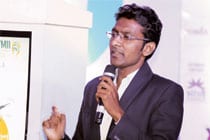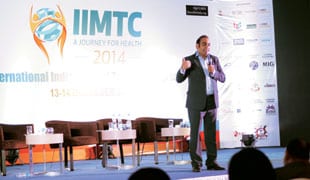Better healthcare across Borders
Providing a platform to highlight the various challenges faced by medical travellers, the International India Medical Tourism Congress witnessed discussions on strategies to educate and spread awareness to further the growth of medical tourism in India By Archana Sharma
The first ever two-day International India Medical Tourism Congress (IIMTC) – ‘A journey for Health’, recently held in Delhi from December 13 to 14, 2014, saw participation from around 20 countries like Nigeria, Thailand, Singapore, Malaysia, USA, UK, Brazil, Afghanistan, Turkey, South Africa, etc with over 150 delegates. Elaborating on the need for this initiative, Dr HN Garg, consultant critical care, Max Super Speciality Hospital, and chairman, IIMTC, stated, “Medical tourism is a broad term and to understand all its aspects better, such platforms are required but none had been organised so far. A lot of people are interested in understanding this segment and utilising its potential better. Therefore, keeping this in mind, we initiated this conference with various sessions on leadership, equipment and technology, global insurance and the finance and investment required in this sector.”
Addressing the delegates, Dr Lalit K Panwar, secretary, ministry of tourism (MoT), Government of India, talked about the unique position of tourism in India with the new government at the helm. “India is poised for mega launches and thereby is increasing its global visibility and accessibility. It is the right time to benefit from the potential of medical tourism with the global industry being at more than US$ 60 billion. The Indian health sector is a US$ three billion industry and therefore we should look at developing it better and ensuring that we tap its maximum potential,” he said. Also highlighting the importance of better marketing and promotion, Panwar added, “We should look into creating a global brand like ‘Incredible India’ for medical tourism also and launch an international media campaign to promote India as an affordable but world class medical centre and facilitator.” Talking about the electronic visa on arrival scheme, he added that MoT is looking at adding another 50 countries to the already approved 43 countries list, which will include other source markets for medical tourism and thereby helping this segment better.
Tapping the potential
At present there are over 100 countries trying to promote medical tourism. The Indian medical tourism industry is expected to reach US$ six billion by 2018. Currently, the size of the medical tourism industry in India is estimated at a little over US$ three billion, with tourist arrivals estimated at 2,30,000. According to Dr Prem Jagyasi, managing director and CEO, Dr Prem & Associates, Mumbai, “Most of the countries are undergoing healthcare crisis in the world today, with over 250 million people in the US still uninsured. In the developed countries the healthcare is costly while the developing countries are able to provide high-end facilities to mostly high-end clientele. Also better facilities are available to people who are willing to travel for them.” He also opined that the key factors that should be kept in mind, for medical tourism and travel are affordability and accessibility. “In a survey done with the help of medical tourism experts, the key factors for deciding a destination are quality, technology, accessibility, recognition, popularity and governmental support. Social and cultural differences are also considered,” added Jagyasi.
Global perspective
 Travelling for medical reasons is a tough choice for people and they face challenges like accessibility, affordability and availability. India is amongst the top 10 destinations for medical tourism alongside Thailand, Singapore, Malaysia, South Korea, Hungary, Turkey, etc. According to Dr Anil Bankar, researcher, Dr Prem & Associates, Mumbai and guest lecturer, Dr Babasaheb Ambedkar Marathwada University, Aurangabad, “There is a 30 per cent annual growth in India in this segment and the international medical tourism industry is expected to reach US$ 32.5 billion by 2019.”
Travelling for medical reasons is a tough choice for people and they face challenges like accessibility, affordability and availability. India is amongst the top 10 destinations for medical tourism alongside Thailand, Singapore, Malaysia, South Korea, Hungary, Turkey, etc. According to Dr Anil Bankar, researcher, Dr Prem & Associates, Mumbai and guest lecturer, Dr Babasaheb Ambedkar Marathwada University, Aurangabad, “There is a 30 per cent annual growth in India in this segment and the international medical tourism industry is expected to reach US$ 32.5 billion by 2019.”
Discussing the prospects of medical tourism in India, delegates agreed that they are far bigger and better than other countries of the world. Dr Hakan Tarakcioglu, director, Kent Hospital, Turkey, said, “Indian and Turkish medical tourism are similar in nature and issues, as both need to come forward for marketing and promoting services and facilities.” Adding to this, Dr Adewale Alabi, CEO, Global Health Projects and Resources, Lagos, Nigeria, believes that India will soon be the world’s number one country in terms of medical tourism. “In 2012, 47 per cent Nigerians came to India for medical tourism. However, Indian hospitals should start catering to various demands and requirements of international patients including language provisions and local cuisine,” he said.
“In comparison to developed countries, India is 65-90 per cent economically better. There are over 43 per cent people from UK who look at dental treatment in other countries and though a few of them do travel to India, there is a vast majority that is still unable to do so, mainly because of the visa regime here,” stated Dr V Venkatesh, CEO, Apollo White Dental, Chennai.
According to Dr Ajay Bakshi, CEO and managing director, Manipal Health Enterprise, Bangalore, “We need to learn the importance of treating our patients better as only then will we be able to reach the desired results and showcase our quality services.”
Role of tourism facilitators
Medical tourism is a challenging business for a medical tourism facilitator. According to a survey undertaken for medical tourism facilitators, the results highlighted that the medical tourism sector is not in an organised form and there is a strong need to tie-up with domestic as well as international governments to promote it better.
Jagyasi also observed that most facilitators don’t initiate the ‘Continum of Care’ programme or the post-operative care. “This should be done for international patients with the help of partnerships forged with local area hospitals and home city healthcare centres of the clients. Also specialised packages and value added benefits should be created which will also help in brand building and loyal relationships between the clients and facilitators,” he stated. Jagyasi also stated that the main source markets for India are USA, UK, Canada, the under-developed countries and the GCC countries.
Emphasising on the role of travel agents, Bankar stated, “They are the facilitators who undertake hotel reservations and travel arrangements apart from the healthcare part which is taken care by the hospitals.” He also emphasised that at present, we lack trained manpower but our existing staff can be trained through orientation and refresher programmes, which should be especially designed to cater to this need and new and exclusive tourism courses can be implemented to ensure the same.
According to the research of Texas Medical Concierge (TMC), 4o per cent people prefer medical tourism destinations which have good technology and better healthcare facilities. Overall about 87 per cent people prefer places which have high quality facilities, rather than the cost involved. Aanchal Bhatia, clinical psychologist, TMC, New Delhi, stated, “India is able to provide great facilities at only one-tenth the cost, in comparison to other countries and we try to provide our clients with the best facilities available.” Launched in June 2014 in Delhi, TMC is an inbound and outbound end-to-end facilitator for medical treatment and alternative therapies. They have a telemedicine lounge at ITC Maurya, which combines technology and IT services for the benefit of their clients, enabling them to interact with doctors and hospital institutions. They also plan to enter 25 more cities starting January 2015.
Possibilities and challenges
 “The prospects of medical tourism in India are increasing with the improvements in technology and infrastructure, leading to better quality healthcare facilities in comparison to other countries,” stated, Julie W Munro, president, Medical Travel Quality Alliance and CEO, InterMed Global, Bangkok. “Indian hospitals also have issues of privacy about storing the personal information of its patients, and therefore they lose their credibility. International medical tourists have slightly different priorities and they need different and additional protocols,” she added.
“The prospects of medical tourism in India are increasing with the improvements in technology and infrastructure, leading to better quality healthcare facilities in comparison to other countries,” stated, Julie W Munro, president, Medical Travel Quality Alliance and CEO, InterMed Global, Bangkok. “Indian hospitals also have issues of privacy about storing the personal information of its patients, and therefore they lose their credibility. International medical tourists have slightly different priorities and they need different and additional protocols,” she added.
Talking about the lack of support from the government, Jagyasi said, “In India, one of the main issues is the lack of government affiliation and an organised structure for this sector. Even though we are well equipped to handle complex procedures and can provide value for money with our price-value propositions, the infrastructure for medical tourism is lacking.” He also emphasised the need for more public and private partnerships along with more opportunities for networking, as the country requires better partnerships between the different stakeholders of this industry. “We should also consider working with other under-developed countries and look into creating a healthcare cluster and develop it to cater to the needs of the growing market demand,” he added. Adding to this, Bankar stated that India needs to reposition its brand not just as an affordable medical tourism centre but also showcase the world class facilities available.
The conference also stressed upon the need to showcase the Indian medical facilities with better marketing and promotional strategies, as there is a lack of knowledge and understanding regarding the state of facilities available in India in the perspectives shared by different stakeholders. Bankar also said, “We need one national accreditation body to build the brand of medical tourism in India and abroad. We also need to start promoting wellness tourism and not just medical tourism, as this will help us in differentiating ourselves from our competitors.”
Sorav Jain, thinker-in-chief, echoVME, Chennai, stated that in India the medical tourism segment is not an internet friendly sector, even though we are one of the leading internet users in the world. “We need to understand the online and social marketing scenario, wherein we can undertake even one-to-one marketing. Also we need to create social media databases with the help of the information being shared by the users regarding their healthcare requirements, to promote ourselves better. Travel bloggers partnerships are also a good way to implement the same,” said Jain.
Talking about the various marketing strategies that can be undertaken to promote hospitals and facilitators better, Jagyasi believes that PR firms and social media are the best techniques apart from word of mouth marketing. He suggested that an integrated marketing plan with the help of proper exposure and networking opportunities should be undertaken for healthcare and business development with the aim of direct marketing and brand management.
IIMTC also organised two certification workshops for medical tourism facilitators covering topics like branding and marketing this sector, the role of international patient departments, insurance and finance required by this business segment.
Talking about the future of IIMTC, Garg stated that the preparations for the next event are already underway and that more associations will be approached. “We will have an even better participation from the government as well as international bodies and will also look at connecting international governments with the Indian medical tourism stakeholders.


